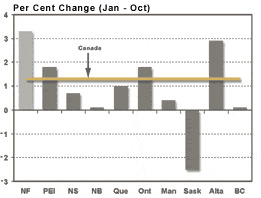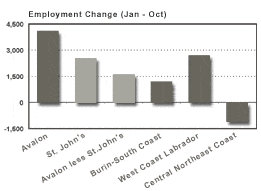
|

|

|
Employment in 2001 is expected to reach a record 211,000. This will represent growth of over 3% from 2000, and 1.7% above the previous record employment level of 207,400 set in 1990.
Growth has been boosted by gains in both the Goods and Services sectors. In the first ten months of 2001, Goods sector employment was up by 3.2%, mainly due to gains in manufacturing and utilities which have more than offset lower fish harvesting employment. Services sector employment was up by 3.3% and should reach a record 164,000 for the year. In this sector, significant gains are taking place in wholesale and retail trade; transportation and warehousing services; professional, scientific and technical services; and management and related services.
Growth in customer call centres has been a leading factor in employment gains in management and related services. Employment at these centres doubled in 2000 and should grow by 25% this year to 3,800. In the last 12 months, four new centres have opened in the Province, all in rural areas.
The unemployment rate for the first ten months of 2001 declined by 0.5 percentage points from the same period in 2000. The rate in 2001 is expected to be 16.4%, the lowest since 1989 when it averaged 15.5%.
|
|
|
 |
|
Source: Statistics Canada Labour Force Survey |
|

|
|
|
 |
|
Source: Statistics Canada Labour Force Survey |
The unemployment rate would have declined more had it not been for strong growth in the labour force. An improving economy over the past few years and strong employment growth this year have fuelled expectations and consumer confidence. This, in turn, resulted in a situation where stronger employment growth encouraged more people to enter the job market. Labour force growth in 2001 is expected to be 2.8%.
Similar to national trends, the provincial labour force is adapting to changing labour markets. Factors affecting workers include: strong growth in the Services sector; increased information and other technologies; the changing nature of work (e.g., more people working part-time); the need for higher educational attainment; and, government policy and legislative changes (e.g., EI reform).
These factors are reflected in the changing composition of the labour force. This year, about 55% of the employed will have completed post-secondary studies compared to 45% in 1990. Part-time employment now accounts for about 14% of total employment compared to 12% in the mid-1980s. Finally, growth in the Services sector, which tends to be female dominated, has resulted in the female share of employment rising from 44% of total employment in 1990 to 47% this year.
|
|
|
 |



